
Patrol Squadron 10 (VP-10) is a United States Navy Patrol Squadron based at Naval Air Station Jacksonville in Jacksonville, Florida, United States. It is nicknamed the "Red Lancers" and is equipped with the Boeing P-8A Poseidon. It is the third squadron to be designated VP-10. The first VP-10 was redesignated VP-2D15 on 21 September 1927 and the second VP-10 was redesignated VP-25 on 1 July 1939.
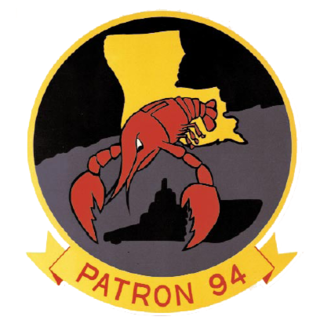
VP-94Crawfishers was a Patrol Squadron of the U.S. Navy Reserve. Originally established on 1 November 1970 at NAS Belle Chase, Louisiana, it was disestablished in September 2006. It was the second squadron to be designated VP-94, the first VP-94 was redesignated VPB-94 on 1 October 1944.

VP-23, Patrol Squadron 23, known as the Seahawks, was a U.S. Navy fixed-wing, anti-submarine and maritime patrol squadron based at Brunswick Naval Air Station, Brunswick, Maine, United States. It was established as Weather Reconnaissance Squadron Three (VPW-3) on 17 May 1946, redesignated as Meteorology Squadron Three (VPM-3) on 15 November 1946, redesignated Heavy Patrol Squadron (Landplane) Three (VP-HL-3) on 8 December 1947, and to Patrol Squadron Twenty Three (VP-23) on 1 September 1948 and disestablished on 28 February 1995. It was the second squadron to be designated VP-23, the first VP-23 was redesignated Patrol Bombing Squadron 23 (VPB-23) on 1 October 1944 and disestablished on 25 January 1946.

The VP-26 Tridents are a United States Navy aircraft squadron based at Naval Air Station Jacksonville in Florida. The squadron flies Boeing P-8A patrol aircraft. It was established as Bombing Squadron 114 (VB-114) on 26 August 1943 and renamed Patrol Bombing Squadron 114 (VPB-114) on 1 October 1944; Patrol Squadron 114 (VP-114) on 15 May 1946; Heavy Patrol Squadron (Landplane) 6 (VP-HL-6) on 15 November 1946, and Patrol Squadron 26 (VP-26) on 1 September 1948. The Tridents are the third squadron to be designated VP-26; the first VP-26 was renamed VP-102 on 16 December 1940, and the second VP-26 was renamed VP-14 on 1 July 1941.

Patrol Squadron Eight (VP-8) is a U.S. Navy land-based patrol squadron stationed at Naval Air Station Jacksonville, Florida (USA). VP-8 is tasked to undertake maritime patrol, anti-submarine warfare (ASW), and intelligence, surveillance and reconnaissance (ISR) missions. The Squadron is equipped with the Boeing P-8A Poseidon.
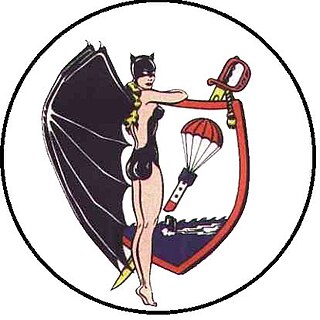
Patrol Squadron 24 (VP-24) was a Patrol Squadron of the U.S. Navy. The squadron was established as Bombing Squadron One Hundred Four (VB-104) on 10 April 1943, redesignated as Patrol Bombing Squadron One Hundred Four (VPB-104) on 1 October 1944, redesignated as Patrol Squadron One Hundred Four (VP-104) on 15 May 1946, redesignated Heavy Patrol Squadron (Landplane) Four (VP-HL-4) on 15 November 1946, redesignated Patrol Squadron Twenty Four (VP-24) on 1 September 1948, the third squadron to be assigned the VP-24 designation, redesignated Attack Mining Squadron Thirteen (VA-HM-13) on 1 July 1956, redesignated Patrol Squadron Twenty Four (VP-24) on 1 July 1959 and disestablished 30 April 1995.
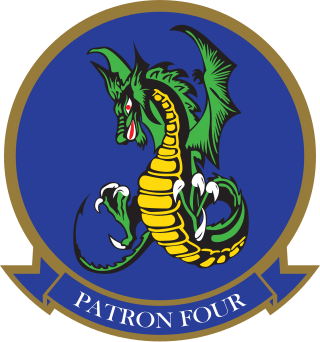
Patrol Squadron Four (VP-4) is a U.S. Navy land-based patrol squadron based at the Naval Air Station Whidbey Island, Oak Harbor, Washington, which is tasked to undertake maritime patrol, anti-submarine warfare (ASW), and intelligence, surveillance and reconnaissance (ISR) missions flying the Boeing P-8 Poseidon.
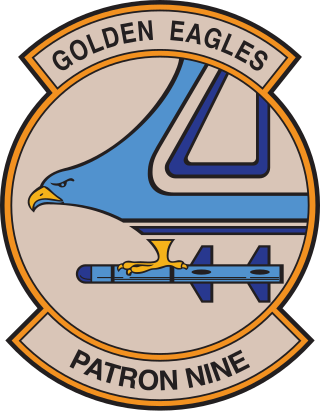
Patrol Squadron 9 (VP-9) is a U.S. Navy patrol squadron with its homeport located at Naval Air Station Whidbey Island. As of 2018, VP-9 is part of Patrol and Reconnaissance Wing Ten, Commander, Naval Air Forces, Pacific.

Fleet Logistics Support Squadron 64 (VR-64), nicknamed the Condors, is a logistics squadron of the U.S. Navy Reserve, based at the Fort Dix entity of Joint Base McGuire–Dix–Lakehurst. The squadron was established as Patrol Squadron 64 (VP-64) on 1 November 1970 and redesignated on 18 September 2004, after 34 years of service. It was based at NAS Willow Grove, Pennsylvania until it was transferred to the Fort Dix element of Joint Base McGuire–Dix–Lakehurst in 2011. Units of the squadron made 26 major overseas deployments.
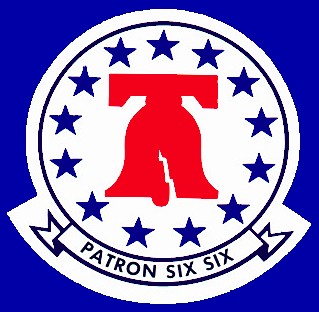
VP-66 was a patrol squadron of the U.S. Navy Reserve. The squadron was established on 1 November 1970 at NAS Willow Grove, Pennsylvania, where it was based for the rest of its life. It was disestablished on 31 March 2006, after 25 years of service. The squadron's nicknames were the Flying Sixes from 1971 to 1974, the Dicemen from 1975 to 1980, and the Liberty Bells from 1981 onward. Elements of the squadron made 19 major overseas deployments.

VP-68 was a Patrol Squadron of the U.S. Navy Reserve. The squadron was established on 1 November 1970 at NAS Patuxent River, Maryland. Its home port moved to Naval Air Facility Washington in 1985. The squadron was disestablished on 16 January 1997, after 26 years of service. Its nickname was the Blackhawks from 1972 onward. Elements of the squadron made 28 major overseas deployments.
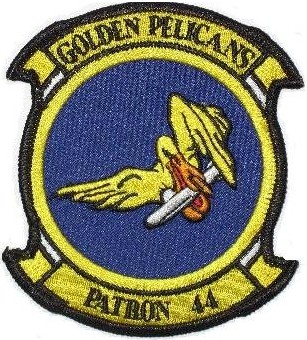
This VP-44 was a long-lived Patrol Squadron of the U.S. Navy. The squadron was established on 29 January 1951 at NAS Norfolk, Virginia and disestablished 40 years later, on 28 June 1991, at NAS Brunswick, Maine. Units of the squadron made 40 major overseas deployments. Its nickname was the Golden Pelicans from 1961 to 1991, and it was also known as the Budmen from 1989 to 1991. The squadron had four different insignia during its lifetime, featuring a marlin, King Neptune, a cartoon pelican, and, finally, a more formal pelican design. It was the fourth squadron to be designated VP-44, the first VP-44 was redesignated as VP-61 on 6 January 1941, the second VP-44 was redesignated VPB-44 on 1 October 1944 and the third VP-44 was disestablished on 20 January 1950.

Patrol Squadron FIVE (VP-5) is a long-lived maritime patrol squadron of the United States Navy. It is the second squadron to bear the VP-5 designation. VP-5 is the second oldest patrol squadron, the fourth oldest in the United States Navy, and the 33rd oldest squadron in the United States military. As of 2019, VP-5 is still active and is based at Naval Air Station Jacksonville, Florida.

VP-6 was a long-lived Patrol Squadron of the U.S. Navy, nicknamed the Blue Sharks. Originally established as Bombing Squadron VB-146 on 15 July 1943, it was redesignated Patrol Bombing Squadron VPB-146 on 1 October 1944, redesignated VP-146 on 15 May 1946, redesignated Medium Patrol Squadron (Landplane) VP-ML-6 on 15 November 1946, redesignated VP-6 on 1 September 1948 and disestablished on 31 May 1993. It was the third squadron to be designated VP-6, the first VP-6 was disestablished on 3 May 1926 and the second VP-6 was disestablished on 20 June 1945.
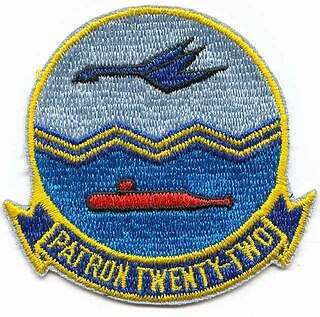
VP-22 was a long-lived Patrol Squadron of the U.S. Navy, nicknamed the Dragons from 1944 to 1950, and the Blue Geese from 1951 to 1994. It was established as Bombing Squadron VB-102 on 15 February 1943, redesignated Patrol Bombing Squadron VPB-102 on 1 October 1944, redesignated VP-102 on 15 May 1946, redesignated Heavy Patrol Squadron (Landplane) VP-HL-2 on 15 November 1946, redesignated VP-22 on 1 September 1948 and disestablished on 31 March 1994. It was the third squadron to be designated VP-22, the first VP-22 was disestablished, merged with VP-101 on 18 April 1942 and the second VP-22 was redesignated VPB-22 on 1 October 1944.
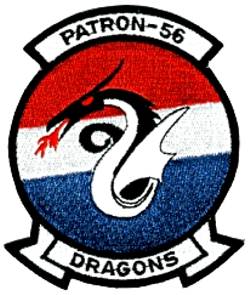
VP-56, nicknamed the Dragons, was a long-lived Patrol Squadron of the U.S. Navy. It was originally established as Patrol Squadron VP-900 on 1 July 1946, redesignated Medium Patrol Squadron (Landplane) VP-ML-71 on 15 November 1946, redesignated VP-661 in February 1950, redesignated VP-56 on 4 February 1953 and disestablished on 28 June 1991. It was the second squadron to be designated VP-56, the first VP-56 was redesignated OTS on 1 July 1941.
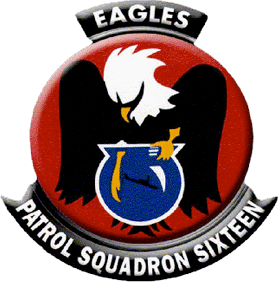
VP-16, nicknamed the War Eagles, is an active Patrol Squadron of the U.S. Navy. It has been based at NAS Jacksonville, Florida since its founding in 1946. The squadron's mission is to operate Maritime patrol aircraft to the fleet in support of national interests. The squadron's radio callsign is "Talon," and their tailcode is "LF." Originally established as Reserve Patrol Squadron 906 (VP-906) in May 1946, it was redesignated Medium Seaplane Squadron 56 (VP-ML-56) on 15 November 1946, redesignated Patrol Squadron 741 (VP-741) in February 1950 and redesignated Patrol Squadron 16 (VP-16) on 4 February 1953. It is the third squadron to be designated VP-16; the first VP-16 was redesignated VP-41 on 1 July 1939 and the second VP-16 was redesignated VPB-16 on 1 October 1944.
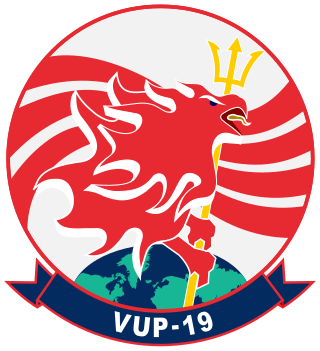
Uninhabited Patrol Squadron 19 (VUP-19) is an unmanned patrol squadron of the United States Navy, nicknamed the "Big Red" and established on 1 October 2013.
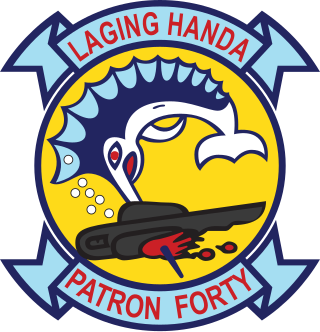
VP-40 is a Patrol Squadron of the U.S. Navy. The squadron was established on 20 January 1951. It is the second squadron to be designated VP-40, the first VP-40 was disestablished on 25 January 1950.
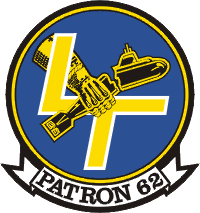
Patrol Squadron SIXTY TWO (VP-62) is a combat aviation squadron of the United States Navy Reserve. Since 31 July 2015, the squadron has been assigned to Commander, Maritime Support Wing, an Echelon IV organization under the Commander, Naval Air Force Reserve. Nicknamed the Broadarrows, the squadron flies the P-3C Orion maritime patrol aircraft from its home station of Naval Air Station Jacksonville, Florida, deploying worldwide. The squadron's aircraft can be identified by the stylized letters "LT" on the vertical stabilizer, the letter "L" being common to all U.S. Atlantic Fleet patrol aircraft, either Regular Navy or Navy Reserve, and the letter "T" being unique to VP-62. The stylized "LT" is also incorporated in the squadron's insignia as worn as a cloth patch on flight suits and flight jackets.
























